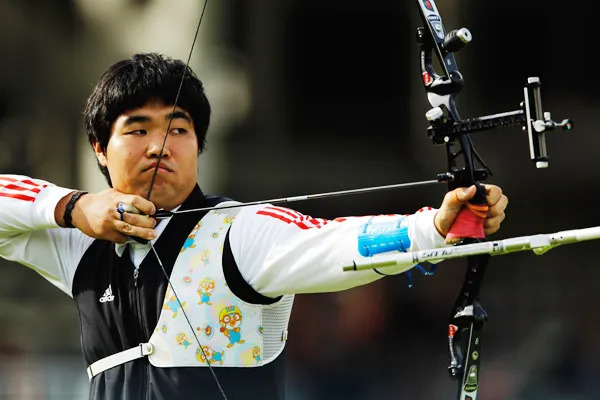This week in the world of sports science, here’s what happened…
- The positives and negatives of supersets
- Why is South Korea so successful at Olympic archery?
- Victor Conteh sheds light on the dark side of the Olympics
The positives and negatives of supersets

Supersets, which involve performing two different exercises successively with minimal rest, are often preferred in resistance training programs to save time. Nevertheless, there is a contentious claim that supersets, even if targeting opposing muscle groups, may induce more fatigue and affect strength gains compared to performing sets of a singular exercise with appropriate rest between sets.
A recent study compared supersets and traditional sets (single exercise sets). The study divided participants into a superset group and a traditional set group. Both groups underwent a 10-week resistance training program, training twice per week, incorporating the following exercises: leg press, bench press, lat pull-down, and seated rows. The superset group completed the program by performing exercises in supersets, while the traditional set group completed all sets of a particular exercise before transitioning to the next exercise.
Noteworthily, the traditional set training group demonstrated significantly greater improvements in strength gains for seated rows and lat pull-downs, while progress was relatively similar for bench press and leg press exercises. Both groups exhibited increased lean muscle mass and reduced body fat mass.
The researchers concluded that traditional set training appears to be optimal for fostering advancements in muscular strength. However, they acknowledged that supersetting whole-body and multi-joint exercises is more time-efficient, particularly for body composition objectives. While the limited amount of exercises in the programs used in this research stands as a notable constraint, this study merits attention for those interested in refining their resistance training program design skills!
If you are interested in enhancing your program design skills, why not check out our excellent and relevant courses Strength Programming and Strength and Power Training
Why is South Korea so successful at Olympic archery?

Im Dong Hyun, a two-time Olympic Gold Medallist, played a pivotal coaching role in leading South Korea to the men’s gold medal in archery at the ongoing Paris Olympics. It’s particularly remarkable as he is legally blind.
Renowned coach and author Joel Cressman recently highlighted Im Dong Hyun’s extraordinary achievements and shed light on the factors contributing to South Korea’s archery success in an X thread. Since 1984, South Korean women have clinched all but one gold medal and currently hold 16 out of 19 Olympic records in archery.
Cressman provided valuable insights into the coaching practices behind South Korea’s archery dominance. He mentioned that a South Korean high school student’s victory in the world championships in 1979 sparked a national obsession with the sport. Additionally, Cressman discussed several coaching methods, including a comprehensive 700-page manual focused on correct form and technique for this single-skill sport. Notably, children are introduced to archery at a young age, practising at half the official distance and utilising rubber bands. They display dedication by training at 6 AM before school and again in the evening after school, aiming to shoot 400-500 arrows daily.
Cressman emphasised that South Korean athletes prioritise the process over results, focusing on mastering technique. He also highlighted the intense competition within South Korea, stating that making the national team is as challenging as winning an international gold medal. Furthermore, successful international participants receive a lifelong pension from the car company Hyundai, serving as a lucrative incentive.
The rigorous training regimen also involves torturous mental preparation through extreme challenges such as bungee jumps, sleeping in cemeteries, and demanding mountain hikes. Moreover, the team practices in front of purposely jeering crowds.
Cressman noted that while this approach has proven effective for South Korea, it may not yield the same results if adopted by other countries. Many may question the extensive repetitive training hours that South Korean athletes undergo and the mental torture they endure. However, Cressman believes that this tailored approach is well-suited for South Korea’s unique circumstances and contributes significantly to their success. However, he does not recommend this approach to other countries and feels that if it is adopted, it is certainly doomed to fail.
We highly suggest checking out Cressman’s insightful tweet here. We previously reported on another fascinating story on Erling Haaland by Cressman that we recommend taking a look at too here!
Victor Conteh sheds light on the dark side of the Olympics
In advance of the commencement of the Paris Olympics, Insider released a shocking YouTube video shedding light on the darker facets of the Olympics. The video, which accrued over 1 million views in a week, features Victor Conteh, a figure known for devising doping programs for his athletes.
Conteh recounts strategies for circumventing doping testing and his involvement in Marion Jones’ tainted three Gold medals at the Sydney Olympics. He highlights the deficiencies of testing agencies and presents instances of concealed doping cases for the sake of averting negative publicity.
Following a prison sentence for illicit steroid distribution, Conteh now asserts his reformation and endeavours as an anti-doping advocate, collaborating with elite boxers. He expresses scepticism about the prevailing testing system and argues the inadequacy of out-of-competition testing strategies leading up to the Paris Olympics.
Conteh argues that doping mainly happens during training, with athletes then reducing their use of performance-enhancing substances to avoid testing positive in competition. He posits that numerous athletes resort to doping to attain a level competitive playing field with their counterparts, given the widespread knowledge of their rivals’ use of performance-enhancing substances. Conteh advocates for the establishment of a more robust testing agency to prevent cheating in sports by finding and punishing athletes who use banned substances.
Whether Conteh’s narrative of personal transformation holds true or not, the video remains a captivating watch. The video emphasises the widespread problem of doping in past Olympics and the unfairness it caused to clean athletes who were potentially deprived of medals by undetected dopers. Let’s hope this is not the case for the Paris Olympics. However, this video may suggest otherwise.
If you are interested in learning more about legal supplements, why not check out our excellent podcast The Sport Supplements That Will Take Your Performance To The Next Level
From us this week:
>> New course: Investigating S&C Practices
>> New podcast: Strength Training Is Essential For Youth Development
>> New infographic: Bio-banding
>> New article: German Volume Training
Access to a growing library of sports science courses
SFS Academy is an all-access membership to premium sports science education.
With SFS Academy, you’ll learn from some of the best coaches around the world as they teach you how to apply the latest research and practice with your athletes.



